This “One Night Stand” almost didn’t happen. As I sat across the table from Fabrice Duffand, International Delegate for the French preservation organization REMPART, and Pierre Housieaux, Director of Paris Historique, all I could understand was that the wonderfully French animated facial and body expressions and gesticulations meant that things were not going well. It did suddenly occur to me that the obstacles inherent when trying to explain why sleeping in a historic space could be of value were multiplied by any language barriers. I sat next to VP of Twisted Preservation, John Yeagley, who was my calm translator. All I could do was sit and occasionally smile in apparent agreement. Preservation is a collaborative and, at times, an adversarial sport – even when the players involved are on the same team.
The opera taking place in front of me turned out to be the core of this “One Night Stand.” The discussion revolved around grass-roots preservation and how it can work under a larger preservation effort umbrella. I do have a bit to say about this concept as I helped run two such organizations, one in Philadelphia (The Philadelphia Society for the Preservation of Landmarks), and the second in New York City (The Historic House Trust for the City of New York). It may not seem relevant to other themes found in these “One Night Stands,” but it actually forms the “meat-and-potatoes” of how and why I pursue these experiences.
With John’s translation, I realized that I generally understood the discussion that was taking place before my eyes. I had many times been deeply engaged in this same conversation. The argument had nothing to do with the concept of the “One Night Stand,” but rather how history is communicated, funded, and prioritized, and how a “One Night Stand” might be able to highlight these often hidden issues of preservation. All valuable and important concepts to define. It’s not about what the site is right now, but rather the dance it took to get to the present state. Such is the story of this particular “One Night Stand.”
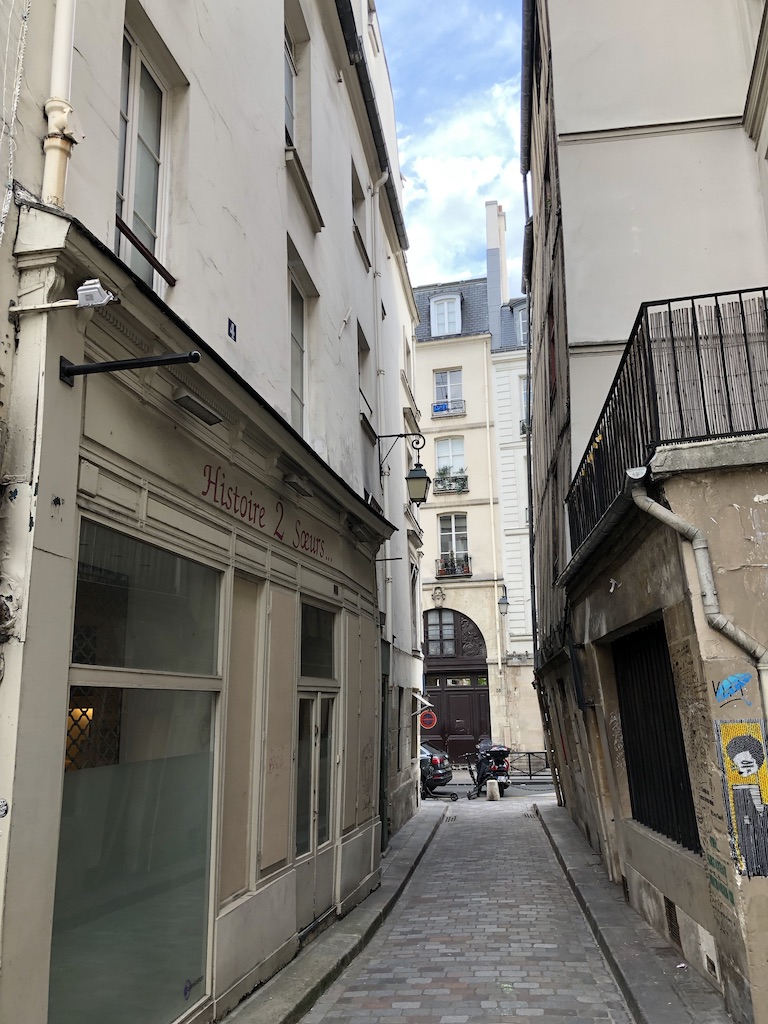


This conversation was taking place in a room on the 3rd floor of the Hotel Ourscamp. The building was to potentially become the location for our first “One Night Stand” in the city of Paris. Fabrice had suggested it because in the early 1960s the Hotel Ourscamp was one of the first buildings to gain notoriety due to the preservation efforts that surrounded it. It would make a fascinating study of the long-term sustainability of preservation efforts. The building, the street, as well as the Parisian precinct it rests within all have a somewhat complicated architectural and social history. The animated conversation of preservation history notwithstanding, this complicated history is one of the very reasons that makes the Hotel Ourscamp so compelling.
GETTING THERE & THE CITY
This passion of the discussion reflects directly the complex evolution of Paris in general and the site of this “One Night Stand” particularly.
The neighborhood surrounding the Hotel Ourscamp is full of narrow roads, buildings buckling toward you, and steep stairs. This area of Paris, now called the 4th arrondissement, contains some of the oldest surviving Medieval structures and urban street configurations of all Paris. But it nearly came to existing only on old maps. Tracing this story provided me with a contextual urban narrative to dovetail with the particular narrative of the Hotel Ourscamp.
Amazingly, much of the street system of the 4th arrondissement is recognizable even today. One of the earliest maps created for the city of Paris is the La ville, cité et Université de Paris by Olivier Truschet Germain Hoyau, c. approx., 1555 (Basel University Library). It shows in amazing detail the built urban environment of medieval Paris. If you zoom into the area that is now the 4th District, you can identify the very block (and perhaps building) of the original Ourscamp Abbey outpost house. Despite a long history as the aristocratic district of Paris, by the late 18th century, the district was no longer the most fashionable district for the nobility. Following the French Revolution, it fell into despair and was abandoned by the nobility completely.
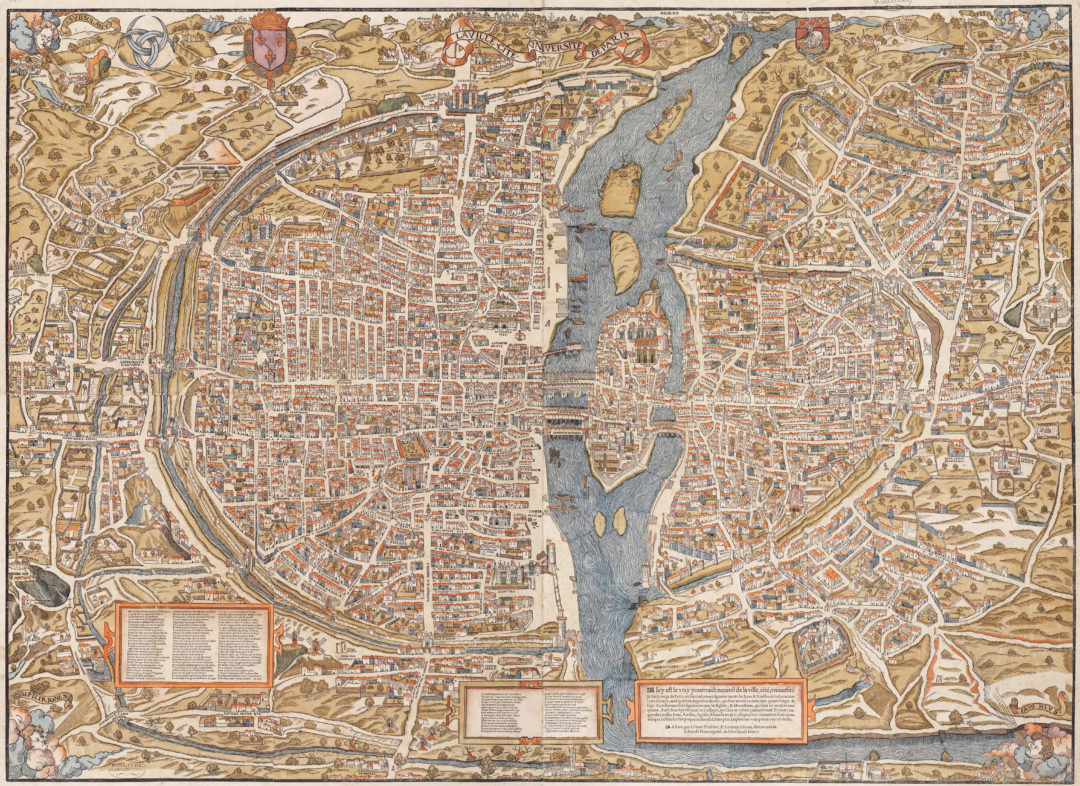

The street that the House Ourscamp rests is presently called rue Francois Miron (originally called rue Saint Antoine). Hotel Ourscamp was built on this road as it was the primary entrance into the city of Paris for merchants traveling from the East. The configuration of the street still maintains the scale, direction, and curvature of the medieval pathway.


Although the center of Parisian commerce in the 15th-18th centuries, by the 1890s the Ourscamp building and 4th arrondissement were in far too decrepit shape to live. It was at this time that the concept of “urban renewal” took hold in Paris. This urban renewal process began as an extensive survey conducted by Paul Juillerat from 1894 to 1904, which revealed problems of hygiene in certain districts of Paris. Specialists likened the occurrence of tuberculosis cases to the high population density, ancient building construction, and in particular to the narrowness of the traffic lanes in relation to the height of the buildings, resulting in a lack of fresh air. Although of some debate at the time, the City Council of 8 March 1906 created a list identifying six “islands of unhealthy areas” of Paris. The public authorities considered it essential to destroy or redevelop these neighborhoods. Hotel Ourscamp was in a direct line for this push for urban removal.


The idea of urban renewal of Paris (and in particular the 4th arrondissement) took many forms and proposals. One of the most dramatic and absolute was produced by one of the master architects of the last century, Le Corbusier. His proposal would have demolished the medieval district – and Hotel Ourscamp – to create a new city. To give you an idea of the potential effects of Le Corbusier’s urban renewal on the fabric of Paris, one only needs to look at the 1922-25 Plan Voisin for Paris. In Corbusier’s idealized and unrealized project, a large portion of the Marias district was leveled to allow for large housing towers with extensive green space surrounding the built form. The medieval streets were eliminated and replaced with regular, gridded vehicular and pedestrian avenues. The only way to gain a sense of orientation is by finding the Île de la Cité and Notre Dame Cathedral, then look across the Seine river. The pressure to eradicate the old in favor of the new was a strong and real potential. The Hotel Ourscamp and many others would have been lost.


“The street consists of a thousand different buildings, but we have got used to the beauty of ugliness for that has meant making the best of our misfortune. Those thousand houses are dingy and utterly discordant one with another. It is appalling, but we pass on our way. On Sundays, when they are empty, the streets reveal their full horror. But except during those dismal hours men and women are elbowing their way along them, the shops are ablaze, and every aspect of human life pollutants throughout their length. Those who have eyes in their heads can find plenty to amuse them in this sea of lusts and faces. It is better than the theatre, better than what we read in novels. “(Le Corbusier and Jeanneret)

This level of urban renewal never took place, in part because of the role that the Hotel Ourscamp played in the public debate regarding the value of historic place vs. the vision for a new modern city. By the 1950s the Hotel Ourscamp was considered too dilapidated to inhabit and further, even to restore. This is when a group of preservationists stepped in and advocated for not only the building but also the entire Maris arrondissement. The city agreed to retreat from their renewal plans only if the preservation group would restore and occupy the Hotel Ourscamp and make it the historic center of the district.


In many ways, the Hotel Ourscamp owes its existence to a slow, tedious, argumentative process involved in city planning and urban reconsideration. Just like the discussion I was witnessing between my two new friends, preservation doesn’t come easily or without a fight. In this case, the fight saved the Hotel Ourscamp.
THE ABBEY OURSCAMP and the HOTEL OURSCAMP


To better understand the location of this Paris “One Night Stand” – the Hotel Ourscamp – we have to start our story out in the French countryside far away from Paris. Hotel Ourscamp was originally built in 1248 as the merchant outpost for the Notre-Dame d’Ourscamp abbey. The d’Ourscamp abbey, located about 50 miles northeast of Paris, was established in 1129 and became one of the most influential, powerful, and wealthy Cistercian monasteries in all of northern France. The name Ourscamp (house bear) goes back to a very old legend that states during the construction of the estate, they managed to harness a bear into pulling a plow to plant the agricultural fields. One of the profitable economic endeavors for the abbey was the agricultural production of staple crops, bringing them into Paris (storing them in the crypt of the Hotel Ourscamp), and selling them in the urban markets to residents. Today the remote abbey complex is a stabilized ruin with a few buildings later renovated for other uses.
The original c.1248 Parisian Hotel Ourscamp was a squat building that contained a sizeable full basement crypt used for storage of agricultural goods to be sold, and two floors of housing for transient monks (who were studying in local libraries), as well as traveling merchants and craftsman. The entire building was made of local stone with the crypt structure designed in the early Norman style of groin vaults. In about 1585 the original stone building was demolished, and a new building was built on the foundation crypt of the original Hotel Ourscamp. The house built in 1585 consists of the main body with a façade, and two floors and a roof at two levels existing under a very heavy French roof. After he Revolution, the abbey was expropriated, the house sold, and small traders inhabited the building. The house underwent many transformations and additions over the 17th, 18th, and 19th centuries, resulting in the facade and interior configuration of today.

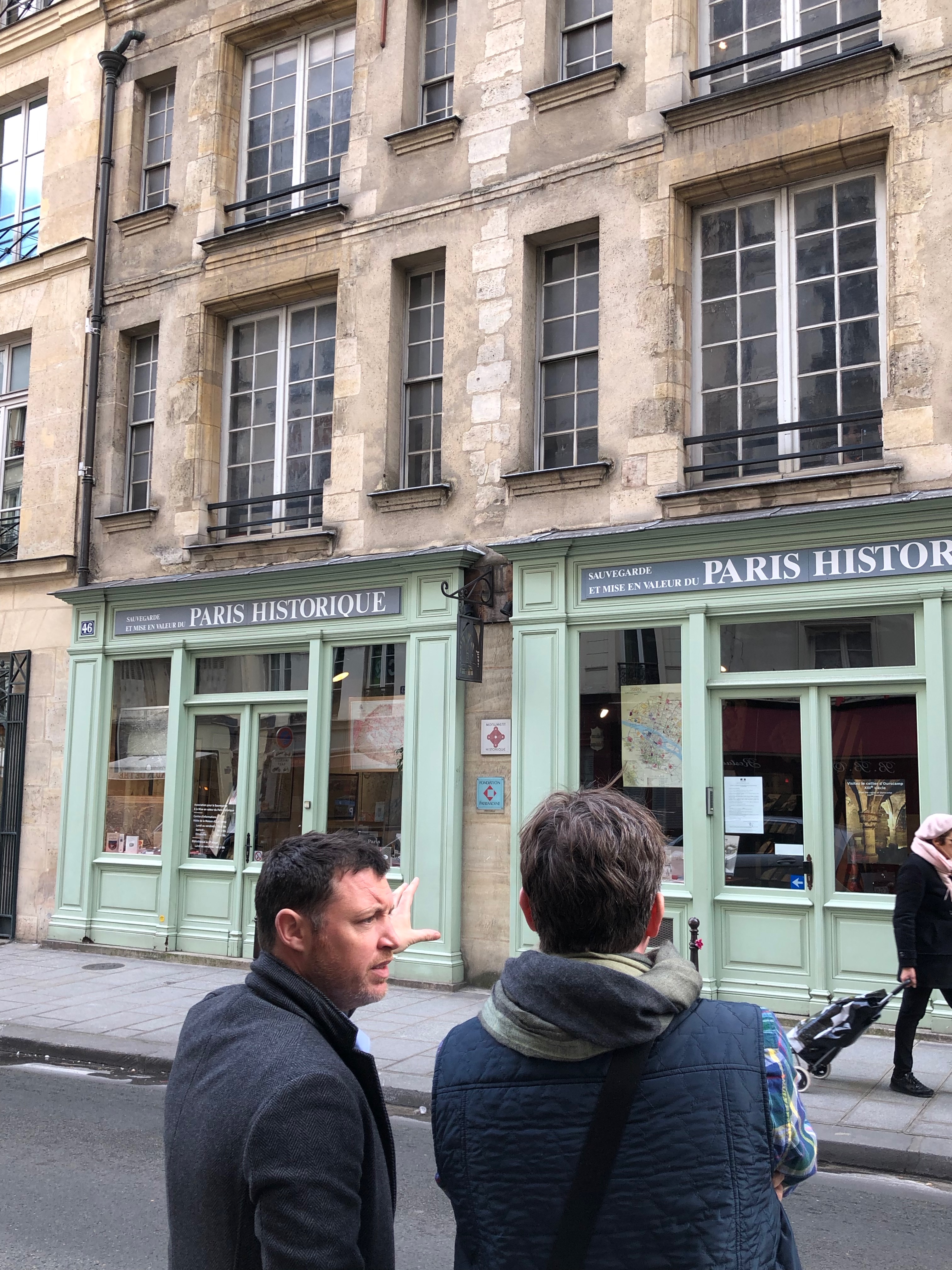
It is because of this somewhat layered and complicated history that REMPART suggested Hotel Ourscamp for a “One Night Stand.” Indicative of preservation in France, our world is never as clearly defined as we try to make it out to be; Hotel Ourscamp stood as a manifestation of the complexities of making sense of history. Here we had a c. 1248 crypt, acting as the foundation for a 1585 building, that in itself had many additions and modifications in the 17th, 18th, and 19th centuries, with 20th and 21st-century restoration efforts currently underway. You can’t get more authentic (and complicated) than that!
Somewhat off the beaten path of the tourist masses, just a few blocks west, this somewhat aesthetically quiet building held within its walls (and basement) a fully authentic and rarely surviving 16th-century crypt. The crypt and multiple-floored structure have been the administrative center of Paris Historique organization as well as a street-level visitor orientation center. The orientation center is stocked full of books, maps, and photographs relative to the urbanism and social history of the city of Paris. This room alone (along with the very friendly greeters) is well worth a visit. Compared to more trafficked history sites just a few blocks away, this highly accessible and non-touristy-center was waiting to be explored.



The location within the building that was chosen for the “One Night Stand” was either the crypt itself or another floor of the building that, just like the original abbey travelers’ building, housed visitors. We chose to sleep on the top floor. Under the weighty roof structure, one big room was used as a storage space for tools used in the continuous restoration of the building. All around our cots were chisels, hammers, ropes, and a myriad of smaller buckets and containers used by the restoration preservationists. In some ways, it felt like sleeping in a tool shed. All of these objects of use served to keep the intellectual concept of restoration alive with the imagined sounds of steel chisels and hammers shaping stone. The ever-present layer of stone dust introduced itself as a fellow traveler – a traveler who was also residing at the Hotel with me.



The temporary quality of the cots felt appropriate, given the transitory nature of the building’s use in medieval times. I imagined the steady flow of visitors from the abbey coming and going at all hours of the day, unloading produce to be sold at the Parisian markets. Rather than feeling like I was staying in a comfortable home, it felt like the center of a wheel tying itself to the abbey, the markets, and the locals. This building served as the unifying element for the Parisian population and the outlying agricultural producers.

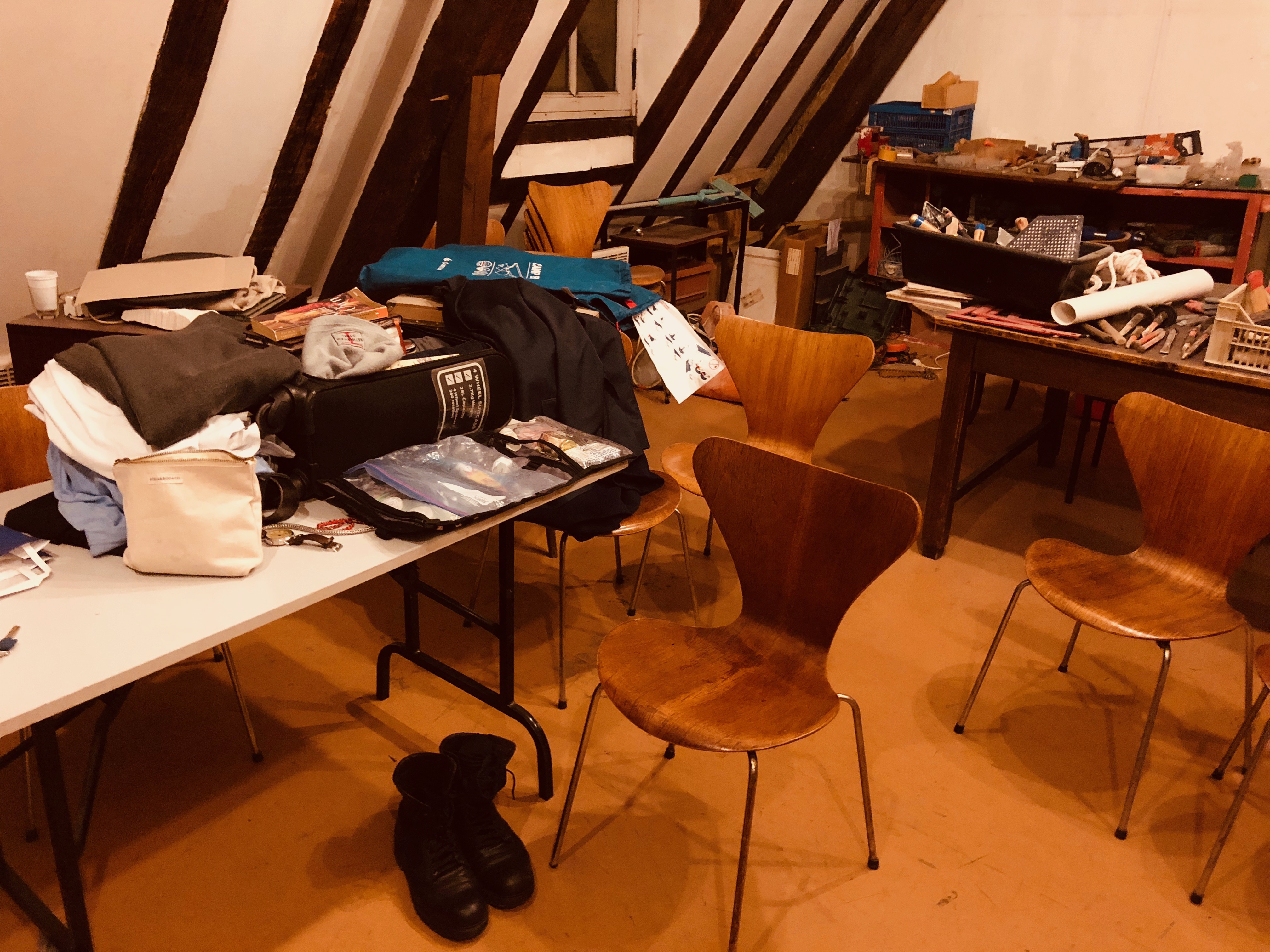

With our cots established and all of our electronics plugged into the outlets, I stepped outside on to a balcony. In the distance, I could hear the church bell of the neighboring St. Gervais and noticed all of the intricate details of the building up close. Of particular interest was how the Hotel met and transitioned to the neighboring buildings. Many times, the historic buildings I sleep in are isolated and separate from the world; however, here I felt like I was a small part of a much larger entity. This concept seems central to a more inclusive view of preservation of the built environment. Contributing to a larger whole in a way that sustains an important fragment of our built environment can be seen as, in some ways, more important than restoring a single building to its “original state.” Every fragment of the whole that is stabilized and connected to the other fragments around it begin to provide a strength of place otherwise impossible.



The only way to get to the any of the floors of the Hotel was through an idiosyncratic and irregularly crafted winder staircase. It is one of the remaining elements from one of the earlier building efforts on the site. The steps are uneven, and the risers vary in dimension. My physical interaction with the staircase quickly became a point of anxiety. I felt like I would fall the entire time I was traversing this wooden obstacle course. My experience on the stairs became a constant aggressive reminder of how regular and standard our lives have become. It would be difficult for someone living in a world of standard architectural codes that regulated things such as stair dimensions and construction to internally and tactically feel and understand the constant present tension involved with authentic history sites and, for that matter, narratives. Our expectations are to even out the irregularities, soften the abrupt connections, and cover up the unsightly repairs to poorly constructed realities. This staircase kept reminding me that authentic history is neither standard, perfect, nor easily understood.



One of the ways that I avoided falling down these stairs was to keep a constant level of connection to the walls that encased the staircase. Even during the night when the light was considerably dimmer, my steady guide was the touch of my hand on the wall surfaces. The walls changed from wood, plaster, stucco, and stone. It was an interesting sensation to be so intimate with the building. There were episodes of gentleness as expressed by some of the smoothed wood, in contrast to the stone and mortar that felt aggressive to my touch. There was real sensuality to my relationship with the building. In many ways, I felt like I was encased in an environment of uneven and highly sensitive conversations. Like an awkward marionette, my foot was balancing upon the surfaces of the everchanging stair treads, while my hands were caressing the walls, while my head was trying not to bang into the low door jambs. Our world seems devoid of such thrilling tactile environmental communications.


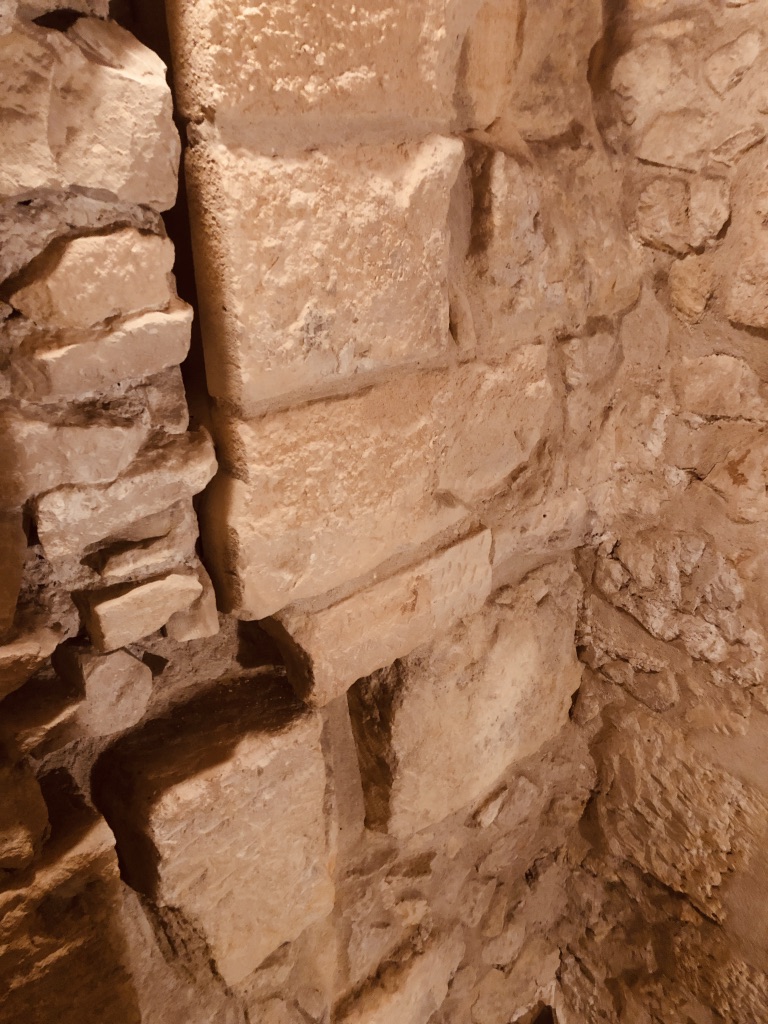
As the sun set, I went over to one of the two dormers that windowed the top floor. Looking out through the warbled glass, the quickly changing sky color reflected off of the surrounding buildings. The transition of daylight to nighttime produced that “Margit” moment where the sky is brilliantly colored while the light quality has diminished. I felt like everything in this experience was transitory, variable, and fleeting. How can one possibly make such a thing knowable? It’s not my particular view of history, but rather what I do with my understanding of that history. Just like this building to the city of Paris, I am only a very small contributing element to the much larger experience, and my understanding of the world around me can be modified and mature as the intellectual environment changes around me.

On the street level, off to the side and out of the way stands a sign on which is written, “ATTENTION ESCALIER DANGEREUX.” Wandering over to the sign, I noticed that it was signaling the presence of a very steep, narrow stone staircase bisected by a fragment of a barrel vault. My hosts told me that the stairs took you down to the original crypt. The crypt was used as the storage space for all of the goods brought in from the abbey to be sold at the Paris markets. The travelers would bring the agricultural products to the crypt through a street-facing door and then climb this interior stair to their temporary sleeping quarters. The condition of the crypt in 196? has been documented by a series of pictures showing that the space was half filled with debris from the many building campaigns on the site as well as the structural collapse of some parts of the groin vaults. It became the first step in the restoration of the building to remove centuries of debris from the crypt. Looking at the pictures of the young preservationists working on the building in the 1960s, you are reaffirmed how collaborative and communal preservation is. It strikes at a group emotional need for continuity and stewardship of significant places.

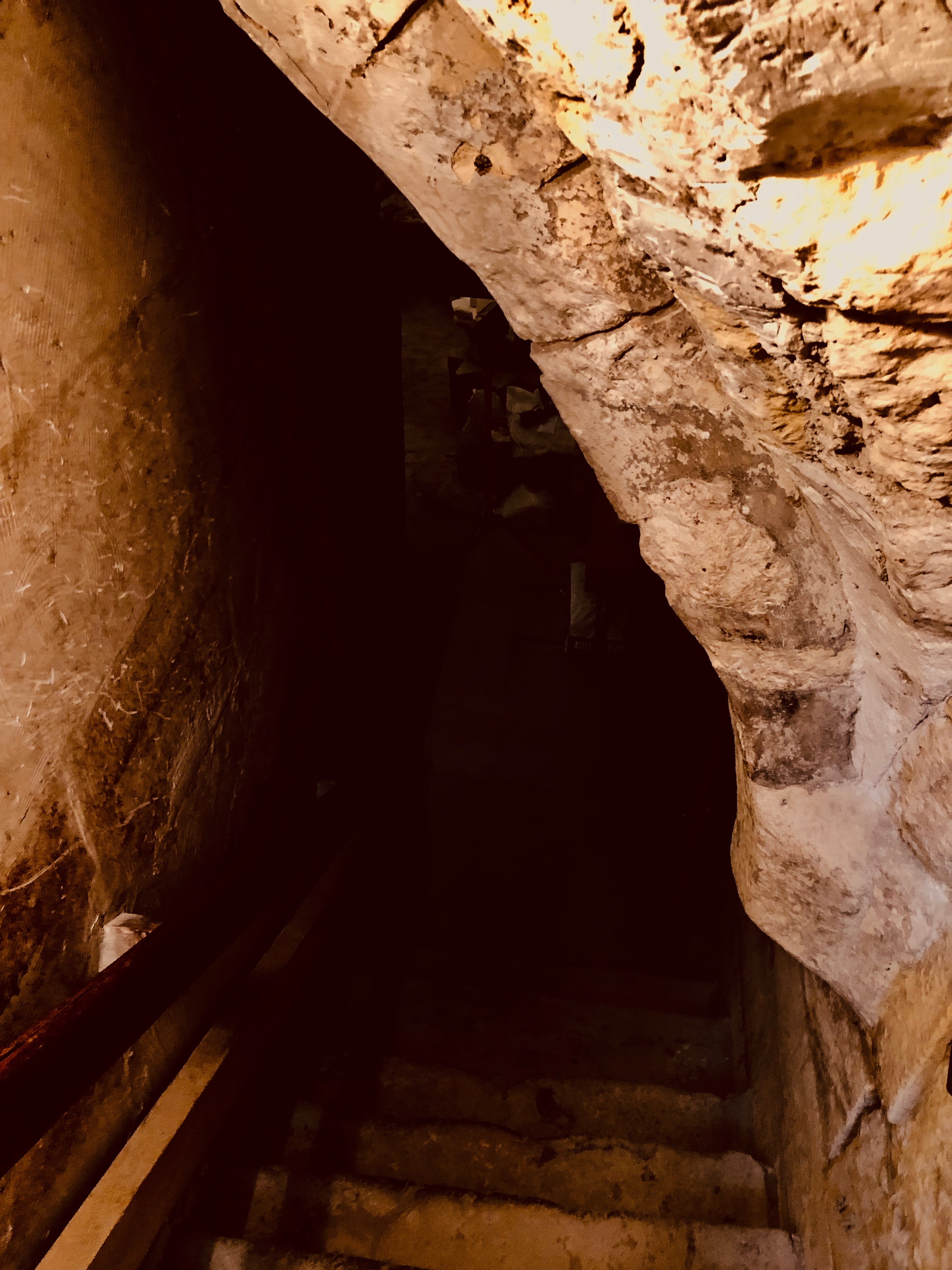


Today the hidden crypt is at the center of the restoration efforts by Historique Paris. Entering the space gives you a visual manifestation of all phases of restoration. The activity and intense effort to restore the crypt is very obvious. It is very rare to be able to get immersive in active restoration efforts. It is a fascinating experience to wander the space and decipher the process and history of the space through visual clues. Scaffolding and wood buttress staging are placed throughout the space as left behind skeletons of activity. To a preservationist like me, the tools of the trade are just as interesting as the structure itself. So much of the process is hidden from the public’s view.

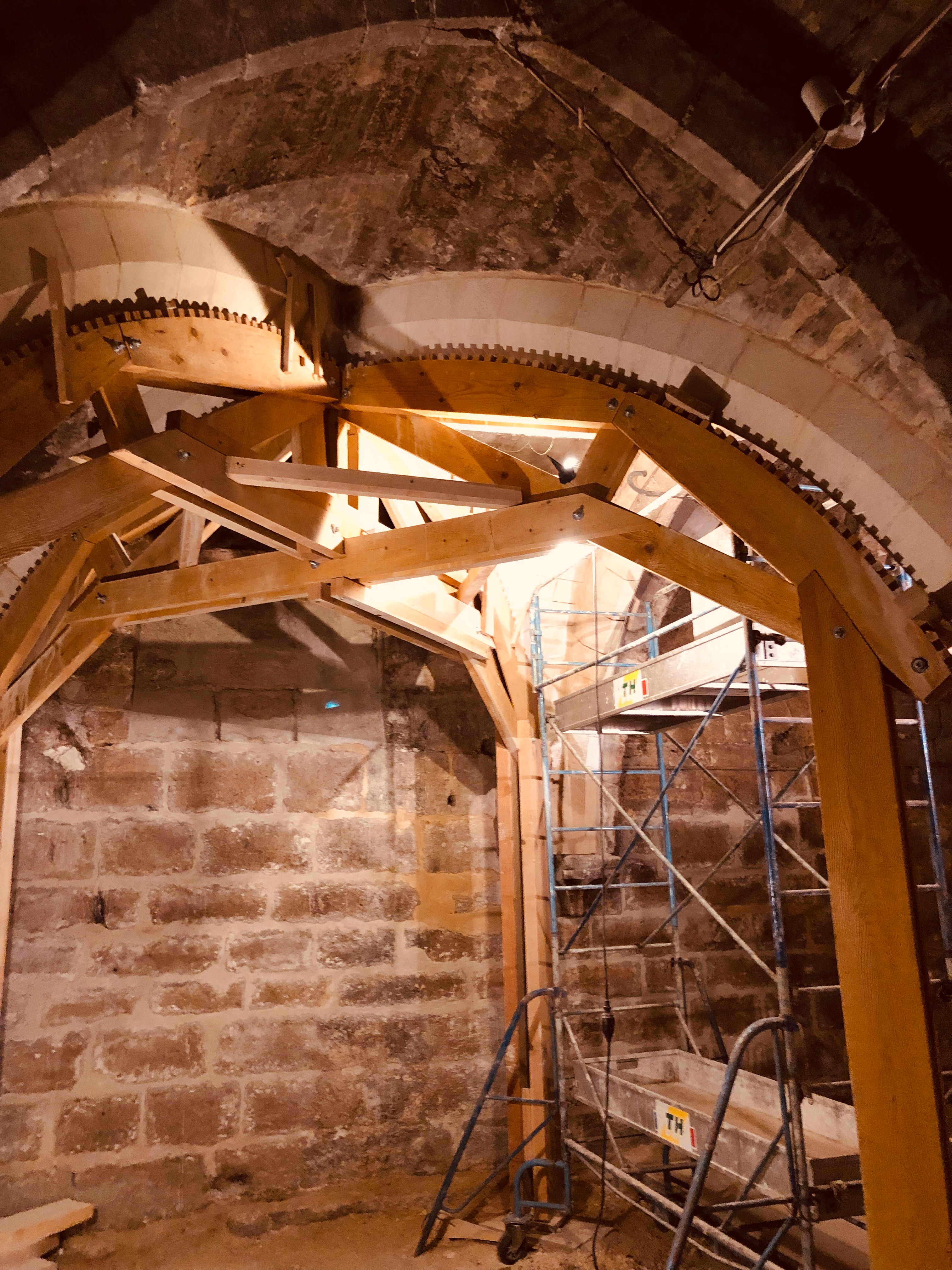


When I visit historic sites, I tend to look for the details and the anomalies to the overall “packaged narrative.” While experiencing the crypt, my eye was pulled, not into the regular spacing and organization of the groin vaults, but the idiosyncrasies of around the edges – the items that caused a disjuncture to the cohesion of the space. One of those was a small wastewater line scurrying out of a hole in the 16th-century foundation wall and traveling straight up into the building above. To the right of the wastewater pipe was a small opening in the wall which opened up onto the street level. The light storming through that tiny space made me realize how dense and dark the crypt felt. On the opposite wall was a mysterious gate which locked off another space and hallway. Upon asking my host, he told me that it goes into the neighboring building. Most medieval foundations of Paris are intertwined with interconnected passageways and odd spacial relationships.
There is something about being in the ground, underneath all of the beauty of Paris, dark and removed from the public facing facade of this extraordinary city, that I felt a connection to the everyday people like myself who lived (and live presently) all around where I am standing. Who preserves those memories? Who preserves those everyday experiences and tactile interactions? Like my hand rubbing along the stone and wood wall as I ascended the spiral stair in the Hotel Ourscamp, who keeps that memory alive? The insignificant. The fleeting. The common?

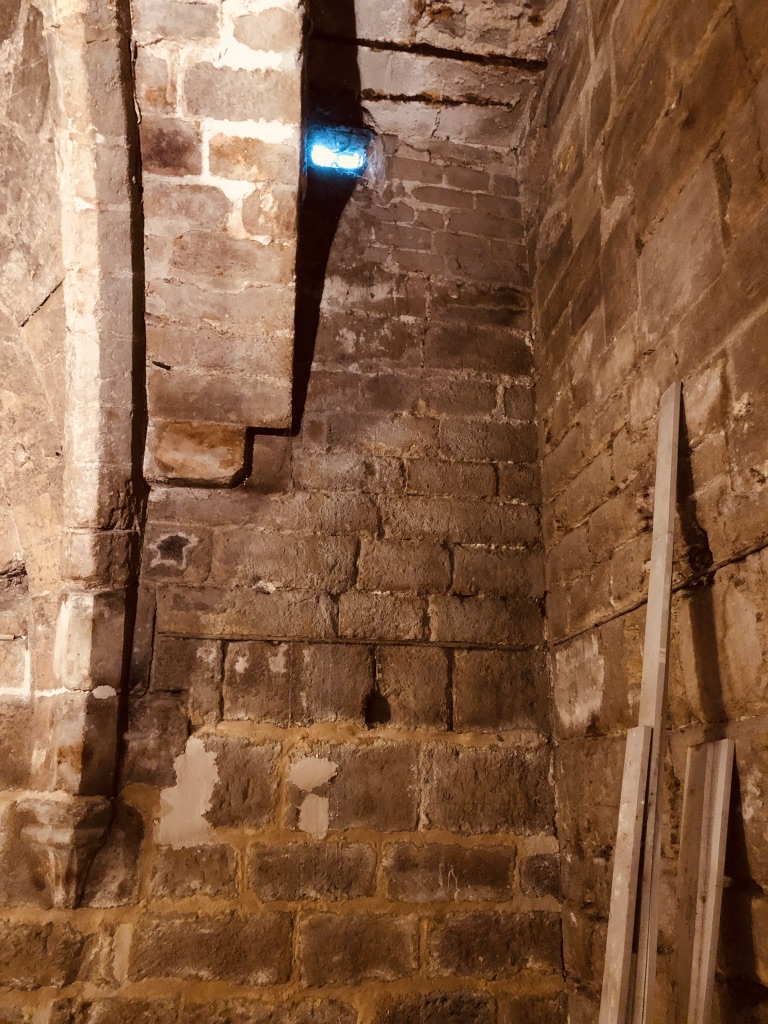


Exiting the crypt, I traveled through time all the way up to the top floor, turned around, and traveled all the way down the stairs to the street level. Catching my breath and sitting on a chair in the now-closed visitors center of Paris Historique, I heard noise coming from the street. It was getting louder and louder. The street felt very narrow so that all of the activity occurring on either side of the street seemed to be occurring directly in front of my view. Suddenly, and without any expectation on my part, streamed a large Parisian Garbage truck. It kept stopping – men would jump off, grab the trash, throw it in the back, and the truck would move on. It was fluid with almost no abrupt stopping or starting. There was something very startling about this experience as I had just come out of the 15th-century crypt and now I was assaulted with the necessities of modern urban city life.
Squinting to the flashing red light atop the garbage truck, I began to image how medieval Paris, with the exception of the Plague, civil wars, and foreign occupation, at a very basic human experience, was full of life, complexity, and the necessities of urban life. The right bank, where Hotel Ourscamp is located, was considered swampy and was occupied by the merchant class who lived and worked close by. It is where the main marketplace was located and considered the commercial center of Paris. It makes perfect sense that the Abbey Ourscamp would build their outpost trading storage and residency building in this area.


In researching the medieval markets of Paris, I became interested in visiting some of the present-day markets. I traversed the city visiting produce and flea markets wanting to get a feel for this layer of the city. We ended up at the Flea market. The environments of the markets were overflowing with unique and eccentric items. The term Marché aux puces literally translates to exactly “flea market.” The largest Paris flea market (and that of the world), located in St. Ouen, was established around 1870, earning its name because of the ostensibly flea-infested furniture and other wares sold at the market just outside of the city’s northern fortifications.
There is something about the confusion and seemingly staccato quality of the Paris flea market that feels somewhat like what medieval Paris itself must have felt like. Much like how Corbusier wrote of Paris itself, “Those who have eyes in their heads can find plenty to amuse them in this sea of lusts and faces. It is better than the theatre, better than what we read in novels.” As I walked down the endless streets of flea market booths, filled with every type of vintage artifact imaginable, I could imagine how some would find this atmosphere anxiety-producing. Perhaps this is how Corbusier felt about walking the streets of Maris. The discordant styles, dirty streets, and the discordant complexities of urban life must have made him fill with anxiety. All one has to do is look at his architecture and see his version of the ideal is housed in a “machine for living” – clean orderly, and consistent.
In some ways, this is precisely where I feel like preservation may have taken a wrong turn. Often, I will see beautifully fully restored buildings exist within a world of sterile perfection. Even in an attempt to preserve, we have the ability to kill the very thing that drives us to preserve it. Not always, but often.
That’s what makes the Hotel Ourscamp so compelling. It’s not perfectly restored, nor could it ever completely fulfill our modern expectations of code-driven architecture. Its architectural presence is so strong, its fragmentary combinations of habitation are so clear, that it stands apart from the world – yet is only clearly visible while it is a part of the world. Its power and quality come from the uncomfortable abruptness it has with our contemporary habitation.
My traversing of the 15th-century stair made it very clear who was in charge – the building – not the inhabitant. Like a Grand Dame, who was so old and had lived through so much, the building felt impatient and abrupt. Not in a negative way, more like your great grandma who was way past trying to impress anyone but was instead living a transparent life of clarity and honesty. There is a point that you can’t cover up the wrinkles or flaws any longer, you can’t suck in your gut to appear skinnier. You are what exists. You exist as a result of your choices, decisions, and natural processes. By accepting that, and embracing the inevitability of time, we become free from expectations and most importantly, nostalgia.
Maybe in some ways that is what Corbusier was searching for, an escape from nostalgia. I wonder if we can bypass nostalgia by simply accepting things as they are and not imposing expectations? Hotel Ourscamp exists both as a fragment of medieval Paris, but also as a part of modern Paris. Its value comes from the simultaneity of these situations. We must be able to hold both images and experiences together in the same place, at the same time, and allowing them to contradict and inform each other. It is both a “beauty of ugliness” as well as a precious and rare artifact. Just like the flea market, when you buy something, bring it home, clean it up, and make it a part of your like – it loses something. There was a power to the companionship of place and challenging proximity of discordant abjectness. Perhaps that should be the goal of preservation – to seek a simultaneous and challenging relationship between the past and the present. Don’t try to resolve the uneven transitions, but rather celebrate those odd connections. Like the passageways I found in the crypt that connected disparate buildings all throughout the Parisian underground, the undiagnosed and unconfirmed are in themselves an element of history worthy of being preserved and valued.
It seems to me that is what Fabrice and Pierre were arguing about – where is that line of ownership, value, and history? What is the level of anxiety and uncomfortable-ness we can accept as we preserve and restore the world around us?



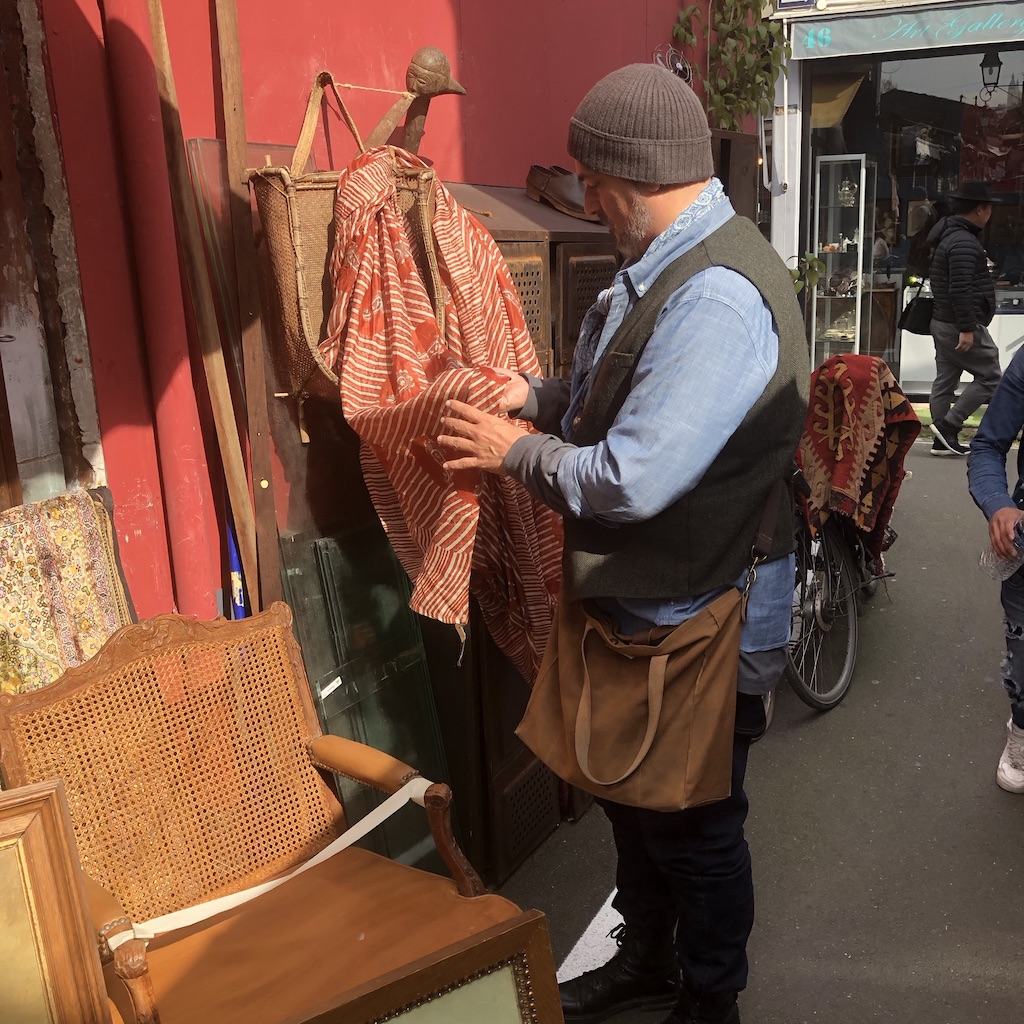




After packing my bags, traveling down the stairs, and walking out of the building and toward the Seine River, I passed Notre Dame Cathedral. It occurred to me that the Hotel Ourscamp and Notre Dame Cathedral existed at the same time in medieval Paris – both existing as fragments, friends of a bygone era. After my experience at Hotel Ourscamp, the scene was overwhelming. I walked through the crowds stopping once to view the Cathedral. The line filled the building and lassoed the entire plaza. I would come back another day to visit Notre Dame. The best I could do that day was to snap a picture from across the street, but there were so many buses that the image I was able to achieve was, at the time disappointing, as you could only see the Notre Dame towers partially, the rest obscured by the busses. Of course, three days later the Cathedral caught on fire. And now, just like Hotel Ourscamp, I am reminded that we now have to hold discordant concepts simultaneously – and move on. What it was, what it is, and what it can be.
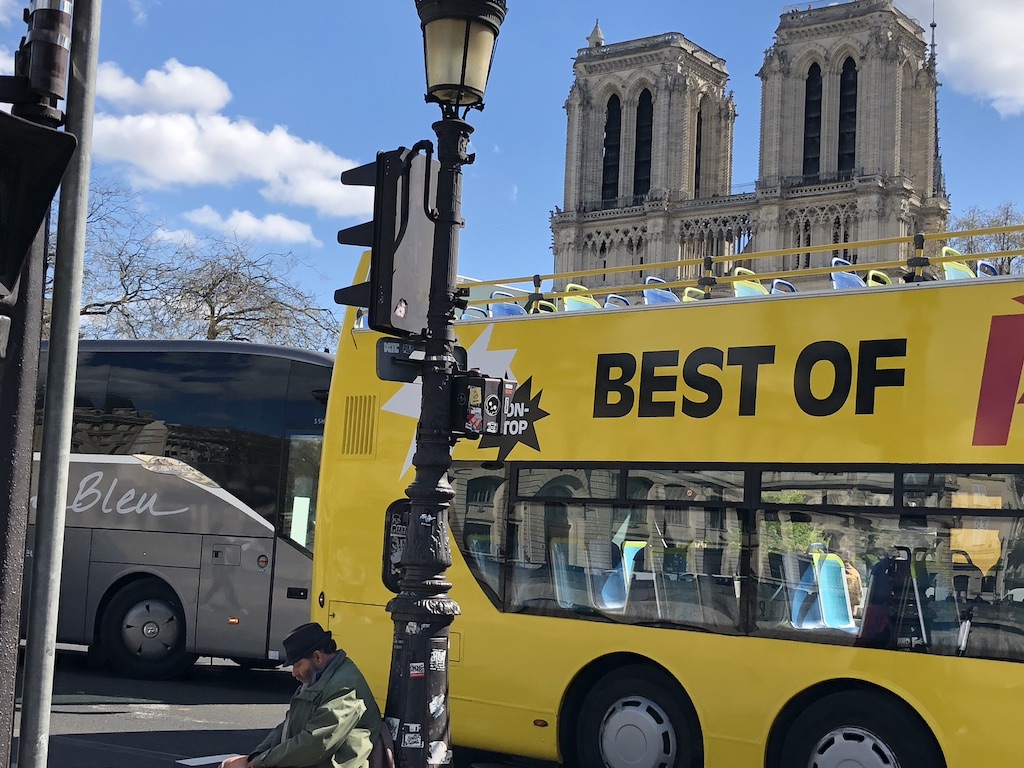
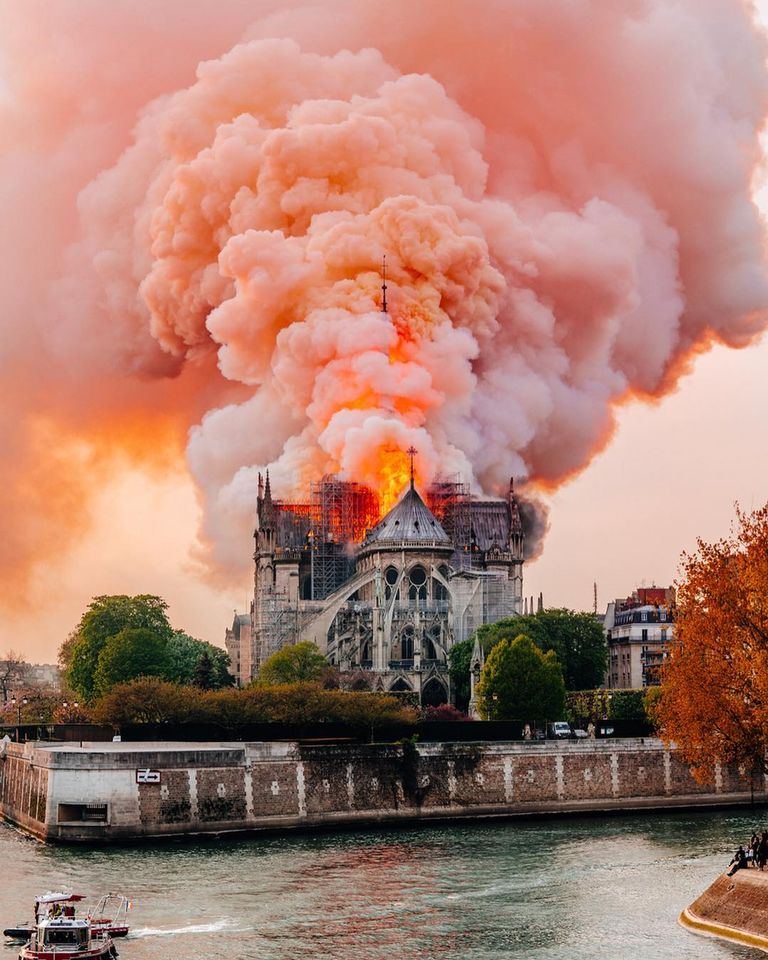
SPECIAL THANKS:
Association Paris Historique – Pierre Housieaux (Director)
REMPART – Fabrice Duffand (International Delegate)
John Yeagley (VP Twisted Preservation) – Research, logistics, and translation
Karen Walter – Editing
